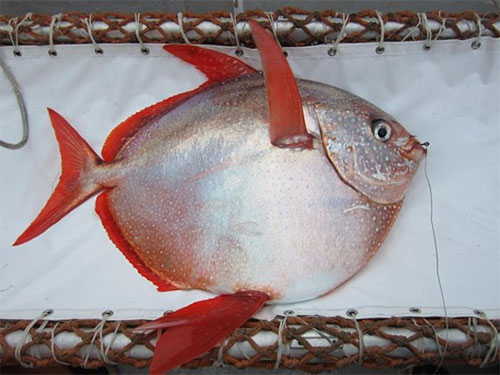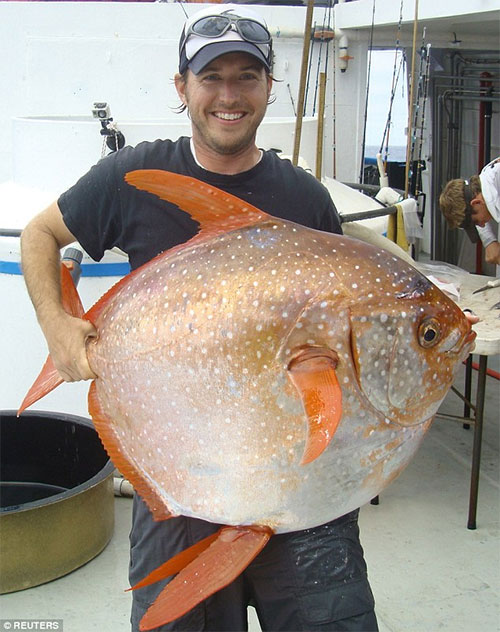Researchers find the first warm blooded fish: Giant 'moonfish' the size of a car tyre flaps its fins to generate heat.
Move over, mammals and birds, and make room for a fish called the opah in the warm-blooded club. Researchers said the deepwater denizen is the first fish known to be fully warm-blooded, circulating heated blood throughout its body, enabling it to be a vigorous predator in frigid ocean depths.
Tuna and certain sharks can warm specific regions of their body such as swimming muscles, brain and eyes in order to forage in chilly depths but must return to the surface to protect vital organs such as the heart from the effects of the cold.
The opah, also called the moonfish, internally generates heat through constant flapping of wing-like pectoral fins, with an average muscle temperature about 7 degrees to 9 degrees Fahrenheit (4-5 degrees Celsius) above the surrounding water temperature at the time. The opah boasts a unique structure that prevents this heat from being lost to the environment.

Warm-blooded animals, such as birds and mammals, and known as endotherms, generate their own heat and maintain a body temperature independent of the environment. Cold-blooded animals, known as ectotherms, include amphibians, reptiles, invertebrates and most fish.
'With a more whole-body form of endothermy, opah don't need to return to surface waters to warm and can thus stay deep near their food source continually,' said fisheries biologist Nicholas Wegner of the U.S. National Oceanic and Atmospheric Administration's National Marine Fisheries Service. 'Nature has a way of surprising us with clever strategies where you least expect them,' Wegner said. 'It's hard to stay warm when you're surrounded by cold water but the opah has figured it out.' The opah is a rusty reddish color, has white spots and bright red fins. It weighs up to 200 pounds (90 kg) and is about the size of a car tire, with an oval body shape. Found in oceans worldwide, it spends most of its time at depths of 165-1,300 feet (50-400 meters), hunting fish and squid.
A unique structure within its gills lets warm blood that leaves the body core help heat up cold blood returning from the gills' respiratory surface, said fisheries biologist Owyn Snodgrass of NOAA and Ocean Associates Inc. The design is known in engineering as 'counter-current heat exchange.' In opah it means that warm blood leaving the body core helps heat up cold blood returning from the respiratory surface of the gills where it absorbs oxygen. Resembling a car radiator, it's a natural adaptation that conserves heat.
The unique location of the heat exchange within the gills allows nearly the fish's entire body to maintain an elevated temperature, known as endothermy, even in the chilly depths. 'There has never been anything like this seen in a fish's gills before,' Wegner said. 'This is a cool innovation by these animals that gives them a competitive edge. 'The concept of counter-current heat exchange was invented in fish long before we thought of it.'
Being warm-blooded gives it distinct advantages over its cold-bodied prey and competitors including faster swimming speeds and reaction times, better eye and brain function and the ability to withstand the effects of cold on vital organs. Fish dwelling at such depths typically are slow and sluggish, ambushing rather than pursuing prey. The researchers documented that opah are warm-blooded by tagging and tracking them off California's coast, measuring their body temperature, water temperature and the depths at which they swam.



